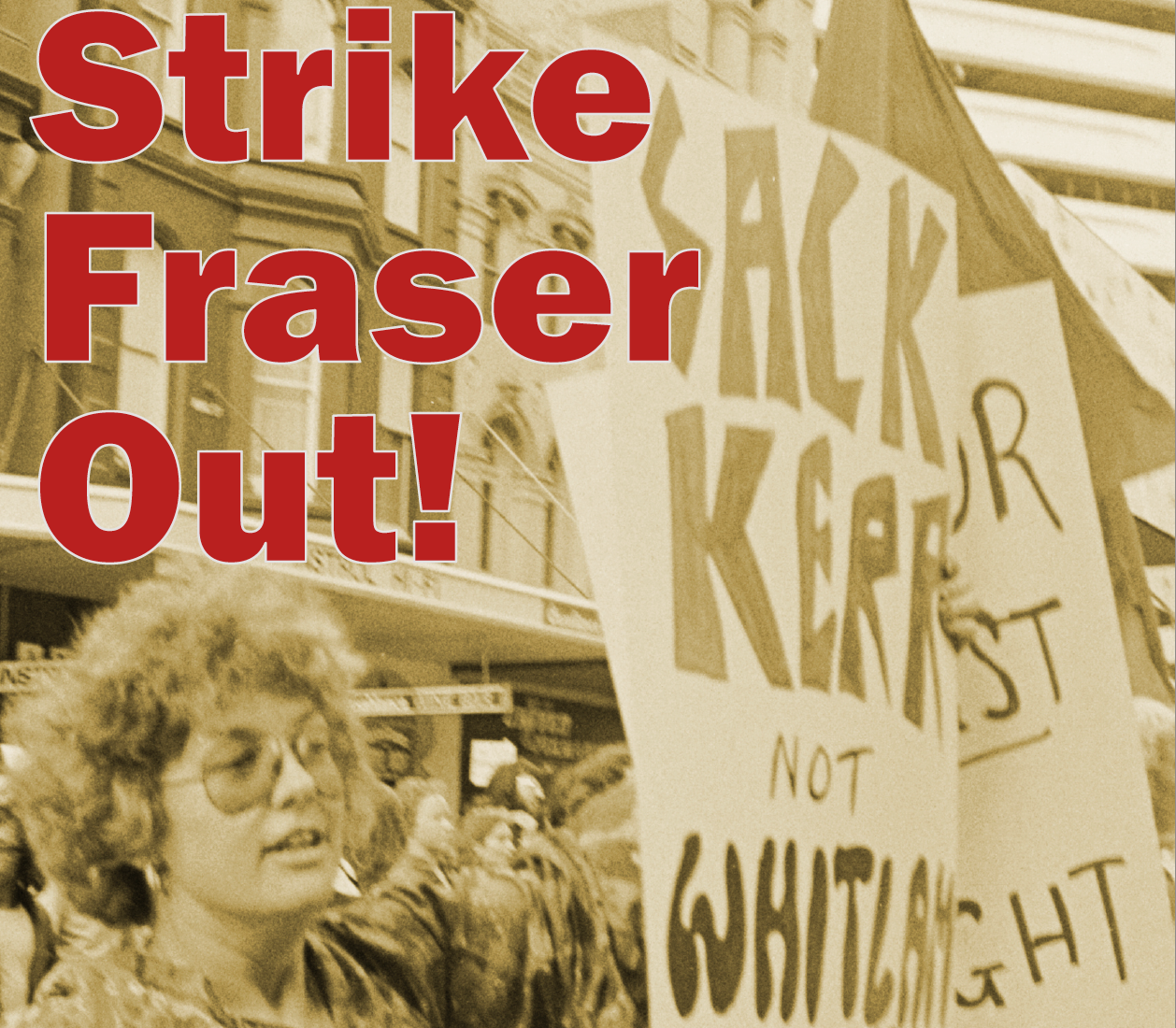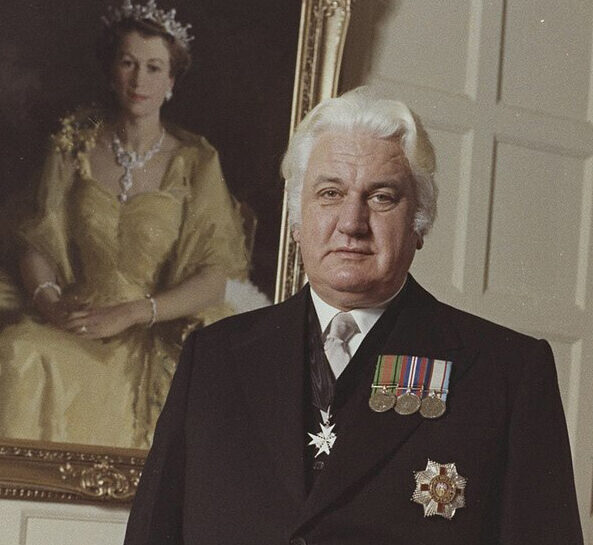On the 50th anniversary of the Whitlam Dismissal, Hamish McPherson reviews Strike Fraser Out: How workers rose up to defend the Whitlam government, October-November 1975, by Phil Griffiths, (Solidarity pamphlet 2025, pp64, $7.00)

The dismissal of the Whitlam government in 1975 was a seismic shock to Australian society. Over the years I’ve talked to many people on the left who can tell you exactly where they were on the afternoon of November 11 and who recall the outrage and spontaneous protests like it was yesterday.
Yet so often accounts of the period focus on mainly on the leading political figures involved or the machinations of the constitutional process.
In this lively and readable account, Phil Griffiths returns class analysis and the working people of Australia to the centre stage, as one of the factors in this tumultuous period. Based on credible research and his own contemporary experience as a socialist journalist, he provides an inspiring account of the determined popular and working-class resistance to Opposition leader Malcolm Fraser blocking government supply and to Kerr’s coup d’etat.
As Griffiths explains, many working people clearly understood at the time that Fraser and Sir John Kerr’s actions were part of a wider ruling class assault on the social and economic gains they’d won and a co-ordinated effort to bring down a “reforming Labor government that had made serious attempts to improve the lives of ordinary people before being engulfed in an economic crisis”.
After 23 years in power the Liberal and Country Parties never accepted the legitimacy of the popularly elected Whitlam government in 1972 and were alarmed by rising levels of workers’ economic struggle and the new social movements against the Vietnam War, for women’s liberation, for ecology and for gay liberation. From the outset they sought to frustrate Whitlam’s reforms and force the government out, first blocking Budget supply in 1974.
A new hard-right leader, Malcom Fraser, found ready allies among the Australian ruling class, conservative state premiers, the bosses, media owners and eventually High Court judges and the Governor-General for his campaign. Together they applied maximum pressure and created the conditions for Kerr to use his Crown executive powers.
Early in the text Griffiths provides a clear-eyed analysis of the undemocratic character of Australia’s constitutional monarchy system of government. He reminds readers that Sir John Kerr exercised his implied powers as Governor-General under the Australian constitution to dismiss the Whitlam government.
Our current constitution vests executive power with the British monarch acting as the Australian monarch, exercised by the Governor-General as head of state, government and armed forces. The Governor-General “may appoint” ministers who “shall hold office during the pleasure of the Governor-General”.
Section 61. Executive power
Constitution of the Commonwealth of Australia
The executive power of the Commonwealth is vested in the Queen and is exercisable by the Governor-General as the Queen’s representative, and extends to the execution and maintenance of this Constitution, and of the laws of the Commonwealth.
While most of the time, the Governor-General respects the advice of the democratically elected parliament and his or her appointed prime minister, this is only a convention and, as the events of 1975 demonstrate, a convention that can be ignored if the Governor-General deems it necessary.
While armed with the powers of a monarchical constitution, Fraser and the establishment also faced a confident Australian working class, with high levels of union organisation, existing rank-and-file networks and a still operational Communist Party. The pamphlet provides a compelling account of how workers and the labour movement mobilised on a mass scale from mid-October 1975 when Fraser blocked Budget supply in the Senate, and again in the weeks following the Dismissal.
Workers across the country repeatedly stopped work and rallied in their tens of thousands during this period, in what Griffiths credibly argues was as a genuine working-class mobilisation that had the power to stop Fraser and Kerr’s coup.
Mass strikes were held in Melbourne and Brisbane, with an estimated 400,000 stopping work in the southern capital on 14 November. So strong was the pressure for further action that an emergency meeting of the Commonwealth Labour Advisory Committee composed of Whitlam, Deputy Prime Minister Frank Crean, Bob Hawke from the ACTU and leading union officials was held. There was “prolonged debate” about calling a national general strike, but a decision taken to instead direct resources into the upcoming election campaign.
Griffiths recounts the key role played by Bob Hawke in containing and quelling calls for action throughout this period. He also draws on contemporary polling, newspaper editorials and interviews with former leading ‘moderate’ Liberals to demonstrate that the widespread resistance was causing splits and a loss of confidence among Liberals and the establishment, who feared that they had over-reached and were discussing a back-down plan.
Many of the unions that led the strikes and protests were led by officials and active networks of shopfloor delegates who were aligned with the Communist Party of Australia (CPA), which had built a genuine social base over decades of political work, despite its long decline and left reformist program.
Again, Griffiths draws on contemporary sources to show how the left union officials and CPA failed to provide an alternative strategy to Hawke and the more general Labor electoralism. At the decisive moment they didn’t provide independent leadership to the mass movement to defeat Kerr and bring down the provisional Fraser government he had installed.
The pamphlet provides a strong analysis of the class dynamics during the 1975 crisis, the contradictions and weaknesses of Laborism and union officials and the real potential for a different outcome.
However, surprisingly absent from the work are more general political arguments or conclusions about how workers and socialists should respond to or challenge Australia’s undemocratic constitutional monarchy system of government.
Missing from the pamphlet is any socialist and republican call to abolish and replace the current constitutional order, including the Governor-General, the unrepresentative Senate, the separation of legislative and executive powers and the Crown powers that made Kerr’s coup possible.
This matters because it’s this political system that continues to serve the Australian ruling class so well, maintaining stability in the interests of investment and capital and constraining compliant Labor governments to only mild incremental reforms. It’s the political order that stops workers taking free industrial action and at a state level is passing repressive laws to restrict our democratic rights to protest.
Our movement needs to pose a confident political challenge and alternative to the current undemocratic constitutional order and highly limited parliamentary system. It should be central to our political program, not an afterthought.
Griffiths rightly points out that the CPA in 1975 failed to have a coherent political alternative to mainstream left Labourism in order to lead the movement at a time of deep political crisis. But the current left in Australia also largely ignores the weighty matter of how society should be governed, including the constitutional order, in favour of a focus on the struggle itself solving these great questions.
However, while the socialist left may be largely disinterested in these questions, we can be sure the bourgeoise devote much time and energy to them. In any future social upheaval, they will use that experience to prevail, unless we develop a confident alternative political program and propose an alternative constitutional order.
A socialist and republican vision needn’t be limited to the symbolic tinkering proposed by the moribund official ‘republican’ movement. Its vision is so limited that nobody is even paying attention anymore.
Instead, the lesson of November 1975 is that we need to overturn and replace the current government and constitutional order and replace it with a democratic republic governed directly by the great majority of society – the working class. We need a radical extension of democracy into all spheres of the economy and society.
Notwithstanding this broader criticism, there is much to recommend Griffith’s engaging work as a great contribution to labour history and our understanding of this decisive period in recent history.
Maintain your rage and enthusiasm! And get your hands on a copy of this pamphlet.

